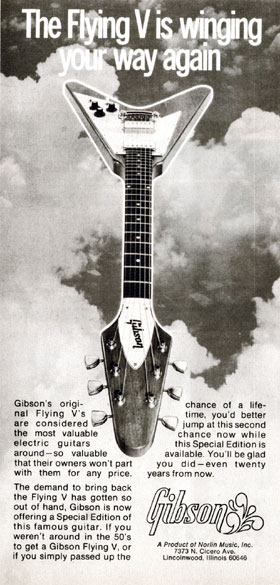



The Gibson Flying V is one of the most iconic guitars of the 20th century, spawning a host of imitators. It was not always this way, and if it had not been due to guitarists such as bluesman Albert King, Jimi Hendrix and Dave Davies of the Kinks adopting the Flying V in the mid 1960s, it may have been forgotten in the midst of time. Albert King was a left handed player (like Hendrix) and was an important influence on his style, and no doubt choice of instrument.
The Flying V story starts in 1957, with Gibson really getting futuristic.. acknowledging that guitar players were hungry for more innovative designs in solid body guitars; designs that echoed the latest in cars, aeroplanes, rockets etc. Perhaps shapes that didn't stick to the same rounded outlines of existing hollow body guitars. Gibson President Ted McCarty came up with three solid guitars in 1958, to complement the Les Paul. They were the Moderne, the Explorer and the Flying V. Unfortunately for Gibson, sales of these lines were small (from 58-59; Explorer - 22, Flying V - 98, Moderne - never commercially available) and they were discontinued in 1959. The image on the left shows the Flying V as advertised in the 1958 Gibson catalog. Luckily Gibson only produced them in small numbers, and were not left with a lot of unsold stock, however this situation means the 1950s Vs and Explorers are some of the most sought after instruments in the world. The 1958 Catalog described the model as follows:
“Gibson leads the way with this "design of the future"... the Flying V model guitar. The swept-back modernistic lines of this really "forward-looking" instrument will be a real asset to the combo musician with a flair for showmanship. The tapered lines provide complete accessibility to all six strings throughout the entire twenty-two fret range”
The 1960s saw a number of high profile artists using old Flying Vs; Albert King, Dave Davies of the Kinks and Jimi Hendrix. In 1967, buoyed by this 'renaissance' of the Flying V, Gibson briefly reissued the model, then again in 1971, and from 1975 onwards. Today the Flying V is one of Gibson's most recognised guitar designs, spawning limitless copies from other manufacturers.
| Issue | Date and Quantity | Wood | Finishes | Distinguishing features |
| Original Flying V | 1957: a few 1958: 81 1959: 17 Some unsold instruments were shipped as late as 1963 with nickel hardware. |
Korina | Dark or light brown | String through body, gold hardware, 3 knobs in line, sharp pointed headstock, black plastic pickup surrounds |
| First reissue | 1966: 2 1967: 111 1969: 15 1970: 47 |
Mahogany | Cherry, tobacco sunburst, natural | Strings attached to tailpiece, vibrola. Pickups mounted in the pickguard (no surround). Three knobs in a triangle with toggle switch. Initially a long pointed headstock, which changed to a shorter more rounded one. |
| Medallion V | 1971: 350 (4 custom made instruments until 1974) |
Mahogany | Cherry | Distinctive 'medallion' on the upper bout of the V. This was to commemorate the upcoming 1972 Olympic games. No vibrola. |
| Second reissue | 1975: 1872
1976: 423 1977: 110 1978: 313 1979: 505 (273 custom built Vs) |
Mahogany | White, natural, ebony, tobacco sunburst, silverburst (from 1980?) | |
| Flying V Heritage | 1982 | Korina | Antique natural, ebony, white | Accurate reissue of the original: string through body, gold hardware, 3 knobs in line, black plastic pickup surrounds |

Advert from a 1975 copy of Guitar Player magazine, announcing the reissue of the Flying V
One of the best examples of Flying V playing recorded has to be Jimi Hendrix playing Red House live at the Isle of Wight in 1970. The majority of his set is performed on a Fender Stratocaster, but Jimi swaps over for Red House, and the contrast in sound of the two instruments is clearly demonstrated.
The 1970s saw reasonably good sales of the Flying V, with 1872 Vs shipped in 1975 alone. But this was certainly not due to Gibson publicity; the V had not been in any Catalog since the launch of the original in 1958, and no pricelist since 1968 (it wasn't listed until 1982). A monochrome advert (left) did appear in 1975 guitar magazines, but that was it, despite the model being shipped right through to at least 1979, or later.
In 1979 the Flying V II was launched, with considerably more publicity than the regular V had received. It didn't last long, and both models were shown in 1981 pre-owners guides; the regular V still being the mahogany model of the 1970s.
In 1981/82 the V2 was deleted from price lists, and two different models launched: the V and the Flying V Heritage. The V was mahogany, with a bound quilted maple top, and "dirty fingers" pickups. The Heritage version had the korina body of the original, and was listed in price lists (from '82) and catalogues (from '83), with the name quickly reverting to just Flying V. This was a very accurate reissue, with all gold hardware, a 17° headstock pitch and strung through the body, rather than to a stop tailpiece.
$5450
$130
$79
$250
$40
$4200
$250
$250
$3000
$98000
$6000
$150
$6850
$33
$5600
$1200
$750
$3995
$2499